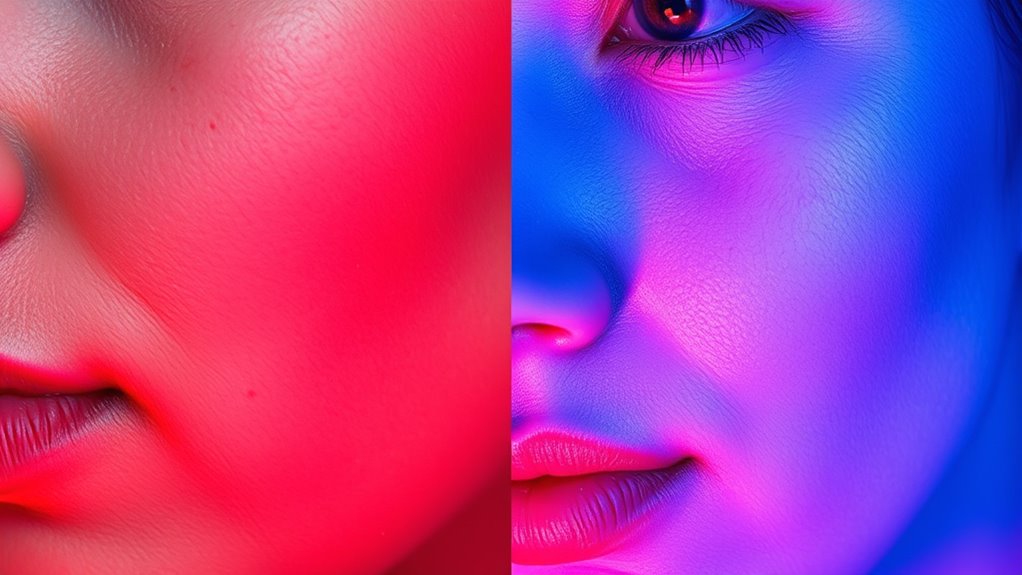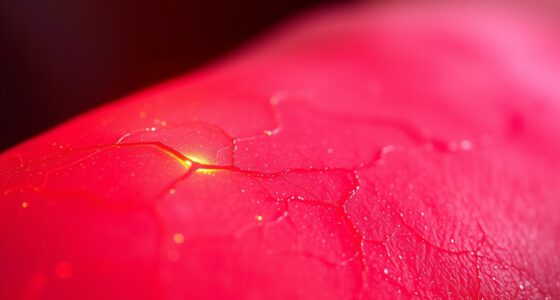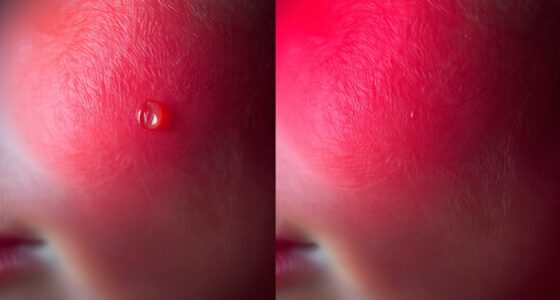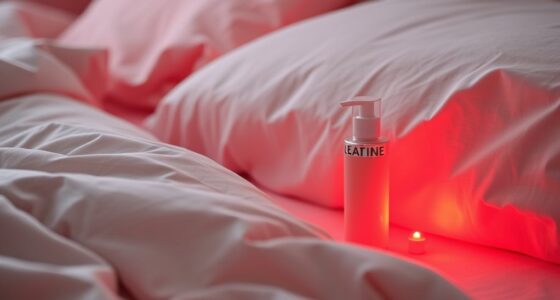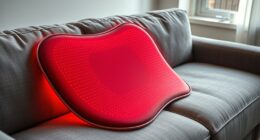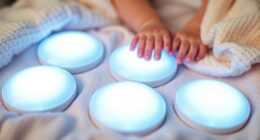Red light therapy penetrates deep into your skin, boosting collagen and elastin production to reduce signs of aging, improve firmness, and enhance overall skin tone. Blue light, on the other hand, targets surface bacteria responsible for acne, helping to clear active breakouts and control oil. While red light promotes long-term skin rejuvenation, blue light is more focused on managing acne and reducing inflammation. To discover how these therapies can benefit your skin, keep exploring their effects.
Key Takeaways
- Red light penetrates deep layers, stimulating collagen, elastin, and blood flow to improve skin firmness and reduce signs of aging.
- Blue light targets superficial bacteria, killing acne-causing bacteria and decreasing oil production for clearer skin.
- Red light promotes healing, reduces inflammation, and enhances skin tone by boosting cellular energy in skin tissues.
- Blue light primarily addresses active acne and bacterial inflammation with limited penetration, focusing on superficial skin layers.
- Both lights can be combined for comprehensive skin rejuvenation and acne management, targeting different skin concerns effectively.
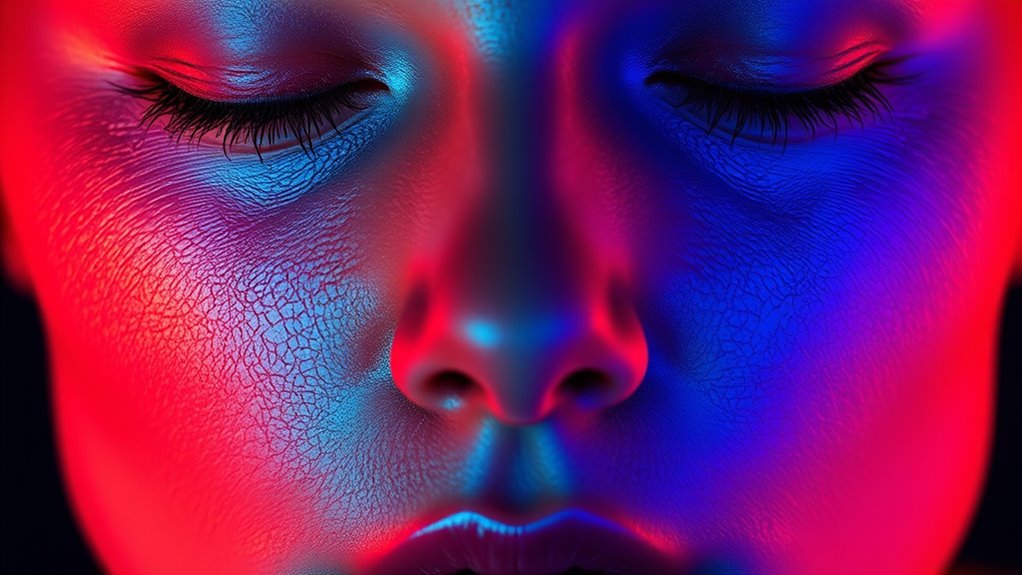
When it comes to skincare, you’ve probably heard about the benefits of red and blue light therapies, but understanding how each affects your skin can be confusing. Both types of light are used in treatments that aim to improve skin health, but they target different issues and work through distinct mechanisms. Knowing what each does can help you decide which might be right for your skin concerns.
Red light therapy mainly penetrates deep into your skin, reaching the layers where collagen and elastin fibers are produced. When you’re exposed to red light, it stimulates your cells’ energy centers, or mitochondria, encouraging increased production of these structural proteins. As a result, red light can help reduce fine lines, wrinkles, and sagging by boosting your skin’s elasticity and firmness. It also promotes blood flow, which delivers more nutrients and oxygen to your skin, aiding in healing and reducing inflammation. That’s why red light is often recommended for skin rejuvenation, scar healing, and reducing signs of aging. Its gentle, non-invasive nature makes it suitable for ongoing use, helping to improve overall skin tone and texture over time.
Blue light, on the other hand, works more superficially, targeting the bacteria responsible for acne. When you expose your skin to blue light, it activates a compound within the bacteria called porphyrins, which produce reactive oxygen species that kill the bacteria. This process effectively reduces active acne breakouts by controlling bacterial growth and decreasing inflammation. Blue light also helps lessen oil production, which can clog pores and contribute to acne formation. Because of its antimicrobial effects, blue light is often used for acne-prone skin, especially when combined with topical treatments. Its shorter wavelength makes it less penetrative than red light, so it’s less effective for addressing deeper skin concerns, but it’s quite helpful for managing active breakouts and preventing new ones from forming.
Frequently Asked Questions
Can Red or Blue Light Therapy Cause Skin Cancer?
No, red or blue light therapy generally won’t cause skin cancer. Think of it like sunlight on a cloudy day—less intense and safer. These therapies use specific wavelengths that target skin cells without penetrating deeply enough to damage your DNA or cause mutations. However, always consult a dermatologist before starting treatments, especially if you have a history of skin cancer or sensitive skin, to make certain it’s right for you.
Is There Any Age Limit for Using Light Therapy?
You can generally use light therapy at any age, but it’s best to consult a healthcare professional first, especially for children, teens, or seniors. They’ll consider your skin type, health history, and specific needs. While it’s safe for most, younger or older individuals might need adjusted treatment plans. Always follow expert guidance to guarantee safe and effective results, avoiding potential risks like skin sensitivity or irritation.
How Long Does It Take to See Results?
You’ll typically see results within a few sessions, often after 4 to 6 treatments. However, it depends on your skin condition and consistency. Some people notice improvements in skin tone, texture, or acne as early as a week, while others may need more time. To maximize benefits, stick to your treatment schedule and follow your provider’s advice. Patience is key for visible, lasting results.
Are There Any Side Effects From Prolonged Exposure?
Yes, prolonged exposure can cause side effects like skin irritation, redness, or dryness. You might also experience sensitivity or minor burns if you overdo it. It’s important to follow recommended treatment times and use proper protection, such as sunscreen or protective eyewear. Listening to your skin’s response helps prevent adverse effects, ensuring you get benefits without risking damage. Always consult with a skincare professional if you notice persistent issues.
Can Light Therapy Replace Traditional Skincare Treatments?
Light therapy can complement traditional skincare, but it shouldn’t replace treatments entirely. You might see improvements in skin tone, acne, or inflammation, but serious skin issues often need targeted, professional care. It’s a helpful addition, yet lasting results usually come from a combination of approaches, including skincare routines and medical treatments. Always consult a dermatologist to determine the best plan for your skin’s needs.
Conclusion
So, when you compare red and blue light, you’ll see that red light promotes collagen growth and healing, while blue light targets bacteria and reduces breakouts. Think of red light as nurturing your skin’s foundation, and blue light as a cleaning crew for acne. Both have their roles, but understanding their effects helps you choose what’s best for your skin needs. Ultimately, using the right light can give you clearer, healthier skin, like a visual blueprint for your skincare goals.
